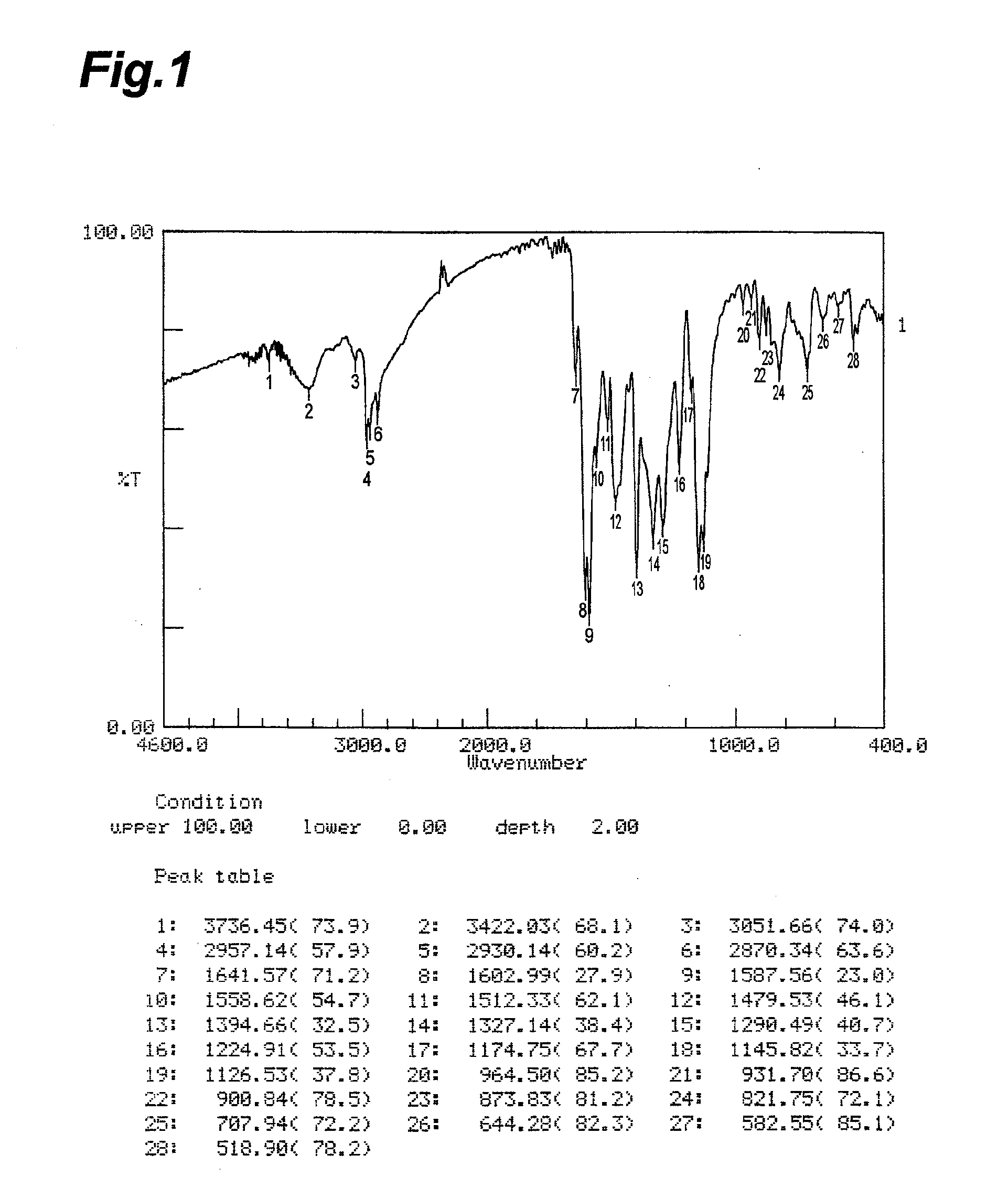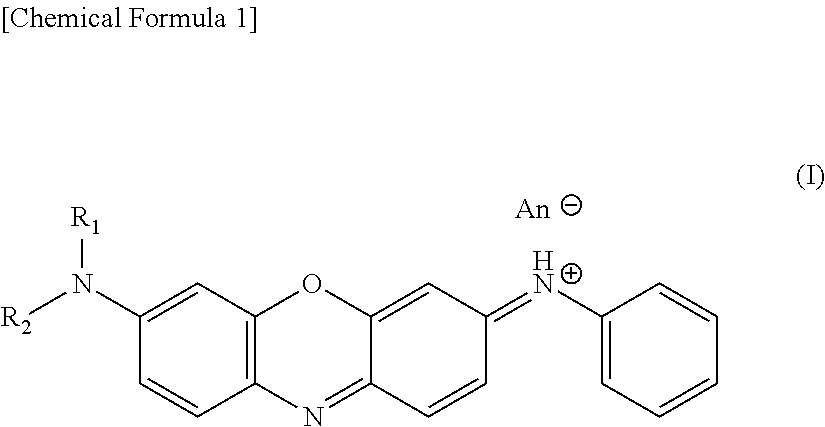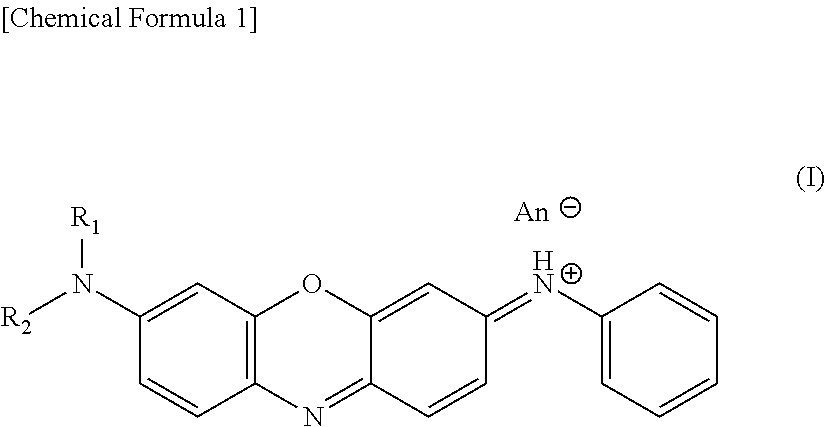Hair dye and hair dye composition
a technology of hair dyeing and composition, which is applied in the preparation of carbonyl compounds by oxidation, anthracene dyes, hair cosmetics, etc., can solve the problems of hair damage, skin allergy reaction, and hair color fading at the time of washing, so as to improve color fastness to light, improve the color fastness, and improve the effect of dyeing properties
- Summary
- Abstract
- Description
- Claims
- Application Information
AI Technical Summary
Benefits of technology
Problems solved by technology
Method used
Image
Examples
example 1-1
[0060]52.8 g of 4-nitrosodiphenylamine (30% wet product) and 150 ml of water were added, thereto were added 17.4 g of N,N-di-n-butyl-m-aminophenol and 570 ml of ethanol, and the mixture was adjusted to pH 1.0 with 35% hydrochloric acid, then 0.9 g of magnesium oxide was added, and the mixture was reacted at 60 to 80° C. for 5 hours while the pH was kept at 1.1 to 1.2 with sodium acetate. Thereto were added 6.6 g of perlite and 1.9 g of active carbon, after stirring for 1 hour, the mixture was subjected to heat filtration to remove impurities, 420 g of hot water was added, 16.1 g of zinc chloride and 45.6 g of sodium chloride were added, and the reaction mixture was left at 20 to 40° C. for 10 hours, then a precipitated crystal was filtered off and dried. A hair dye having the following structure (hereinafter, referred to as a “dibutyl product”) was obtained (yield of 28.8 g).
example 1-2
[0061]217 g of diphenylamine was dissolved in 400 ml of water, 125 g of 95% sulfuric acid and 500 ml of xylene, and 243 g of 40% sodium nitrite and 80 ml of water were nitrosified at 30° C. After liquid separation, 125 g of diethyl-m-aminophenol, 8 g of magnesium hydroxide and 1600 ml of water were added while the aqueous layer were kept at 30° C. or less, and the mixture was adjusted to pH 1.2 with 40% sodium acetate. While keeping the pH at 1.1 to 1.2, the reaction was performed at 60 to 80° C. for 5 hours, and the remaining xylene was removed by steam distillation. Warm water was added to make an entire amount set to be 10 L and the pH was adjusted to 4 to 4.5 with sodium bicarbonate. The insoluble substance was filtered off with perlite and active carbon, 3.2 L of hot water was then added, and the mixture was adjusted to pH 2 with hydrochloric acid. Thereto were added 69 g of zinc chloride and 2730 g of saturated saline, the mixture was left at 20 to 40° C. for 10 hours, the pre...
example 2
Hair Dyeing Method 1
[0065]Dyeing solutions A, B and C prepared from Blue 75 obtained in Example 1-2 based on composition ratios in Table 2 were weighed in an amount of 10 g, respectively, and adjusted to pH 8.5 with monoethanolamine, then 1 g of artificial white hair (100%) (product No. BM-W, Beaulax Co., Ltd.) was placed therein and then dyed at 45° C. for 20 minutes. This dyed hair was washed with water, subjected to soaping under the soaping conditions described below and washed with water, and then dried at room temperature to thereby obtain test samples, respectively. Note that dye concentrations when 10 g of these dyeing solutions A, B and C used to dye 1 g of hair respectively correspond to 1%, 2% and 3% owh (*1).
(% owh (*1): indicates % by weight of a dye with respect to a mass of hair.)
TABLE 2CompositionComposition ratio (mass %)DyeingDyeingDyeingComponentsolutionsolutionsolutionComponentnameABC(a) ComponentDye0.10.20.3(b) ComponentEthanol202020Benzyl alcohol999(c) Componen...
PUM
| Property | Measurement | Unit |
|---|---|---|
| pH | aaaaa | aaaaa |
| skin roughness | aaaaa | aaaaa |
| color | aaaaa | aaaaa |
Abstract
Description
Claims
Application Information
 Login to View More
Login to View More - R&D
- Intellectual Property
- Life Sciences
- Materials
- Tech Scout
- Unparalleled Data Quality
- Higher Quality Content
- 60% Fewer Hallucinations
Browse by: Latest US Patents, China's latest patents, Technical Efficacy Thesaurus, Application Domain, Technology Topic, Popular Technical Reports.
© 2025 PatSnap. All rights reserved.Legal|Privacy policy|Modern Slavery Act Transparency Statement|Sitemap|About US| Contact US: help@patsnap.com



